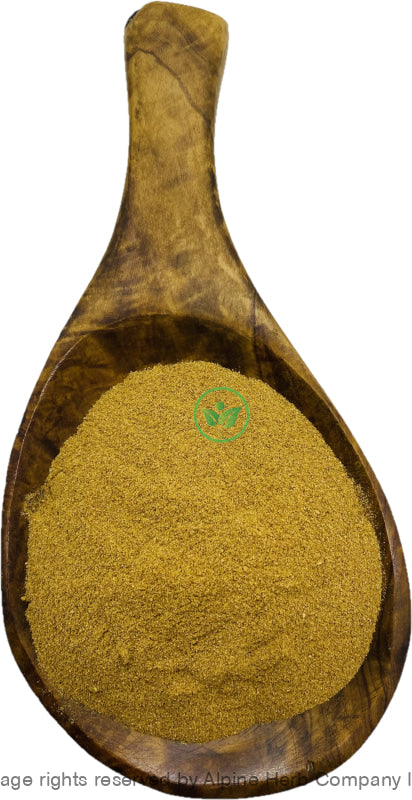Orange Peel Powder Alpine Herb Company Inc.
$ 8,99 $ 5,39
Botanical Name: Citrus sinensis
Common Name:
- English: Orange
- Also, known as: Sweet Orange, Navel Oranges, Narang, Narinch, Narinjh, Narenjhatsaghik, Komola, Xumthira, Xumthira-tenga, Komala, Komalalebu, Malta, Chaang, Guang gan, Tian cheng, Appelsien, Sinaasappel, Porteghal, Appelsiini, Orange (douce), Orange, Apfelsine, Chrisomilia, Portokali, Narangi, Santara, Santru, Mausambi, Narancs, Jeruk (manis), Arancia, Kittale, Naranga, Tungja-namu, Deungja-namu, Kyul-lamu, Orenji, Suwitu orenji, Citrangulum, Portokal, Samtola, Madhura-Naranga, Naragam, Oranchu, Mosambi, Sunttala, Laranja, Laranja doce, Sangtra, Portocal (tree), Portocală (fruit), Apelsin, Nagaaruka, Naranga, Dodam, Naranja, Naranja china, Aranchu, Nagarugam, Nariyagam, Kicchilipandu, Naranji, Kamalakaya, Som, Som kliang, Portakal, Apelsyn, and Santarasi
Habitat: Tropical regions of Asia
Origin: Turkey / India
Harvested: Cultivated
Parts Used: Rind (peel) of fruit
General Information:
Citrus sinensis, the sweet orange is a compact evergreen tree 25-30 foot in height with a rounded, symmetrical crown spreading around15 feet. Oranges are one of the most popular of all the fruits. The evergreen leaves are medium-sized, broad, glossy, leathery, oblong to elliptic, and up to 4 in long; the petioles have narrow wings. The twigs on many orange cultivars are thorny. Orange blossoms are white, five-petaled, sweetly fragrant and arranged in clusters of 2-6, about 2-inch-wide, have a saucer-shaped, 5-pointed calyx and 5 oblongs, white petals, and 20-25 stamens with conspicuous yellow anthers. They bloom in spring and give rise to oranges the following autumn or winter. The fruit is a modified berry known as a hesperidium, and the flesh is divided into segments called carpels. The usual shape of the sweet-orange fruit is round and the color of its pulp orange, but there are variations. The fruit is globose, sub globose, oblate or somewhat oval, 2-4-inch-wide, dotted with minute glands containing an essential oil. The outer leathery peel is comparatively smooth; and the oil glands are convex, orange or yellow when ripe, the inner rind is white, spongy and non-aromatic. Oranges are picked when fully ripe, unlike some deciduous fruits, they do not ripen or improve in quality after being picked. The pulp, yellow, orange or red, consists of tightly packed membranous juice sacs enclosed in 10-15 wedge-shaped compartments which are readily separated as individual segments. In each segment there may be 2 to 4 irregular seeds, white externally and internally, though some types of oranges are seedless.
The oil from the rind is used in food flavorings, cosmetics, and perfumes, and is added to wood-care products to protect against insect damage. The sweet orange differs physically from the sour orange in having a solid center. Most of the oranges grown in California are of 2 cultivars: the ‘Washington Navel’ and the ‘Valencia’. Florida’s commercial cultivars are mainly: ‘Hamlin’, in early season; ‘Pineapple’, in mid-season; ‘Valencia’, in late season.
How to use:
Powdered Herb:
There are different ways to use powdered herb.
Food Preparation: You can add powdered herbs to any super food, herbal smoothie, sauces, spreads and even cookies. Also for children, you can mix powdered herbs with honey or glycerin to make a paste. The thicker the paste, the more potent and herbal in taste. The sweet taste of honey and glycerin will help the medicine go down. This method is also known as “Electuaries”.
Capsules: Encapsulating your own powdered herb at home, give you assurance that the contents of the capsules are pure herb and no filler or any other products. These capsules can be taken with liquid.
Poultice: Poultice can be made with an herbal powder and liquid (mostly water) to form a paste which is then applied to the skin. This method is very helpful for skin conditions.
Herbal shot: Powdered herb can be mixed with water, fruit juice or other liquid to make herbal shot.
Precautions:
You should consult with a qualified healthcare practitioner before using any herbal products, particularly if you are pregnant, nursing, or on any medications.
All information on this website is for educational purposes ONLY.
This information has not been evaluated by Health Canada.
This information is not intended to diagnose, treat, cure, or prevent any disease.
| Unit Size | 100g, 200g, 400g, 1kg |
|---|
Prompt shipping and expert packing
Thanks to our longstanding association with UPS FedEx DHL as well as other leading global carriers, we can offer a variety shipping options. Our warehouse staff is highly trained and will be able to pack your goods in accordance with our precise and exact specifications. Your items will go through an exhaustive examination before they will be securely packaged before being delivered. We ship to hundreds of thousands of customers daily in different countries. This is a sign of our determination to become the largest online retailer worldwide. Warehouses and distribution centers are located throughout Europe as well as in the USA.
Note that orders containing multiple items are processed according to the particular item.
We will thoroughly inspect all items ordered before shipping. Most orders are shipped within 48 hours. The delivery time will be between 3 and 7 working days.
Returns
The stock market is always changing. It's not entirely managed by us since we're involved with several entities, including the factory and the storage. Therefore, the actual inventory could fluctuate at any moment. Please be aware that it is possible that your order could be out of stock after you've placed your order.
Our policy lasts for 30 days. If it's been more than 30 days since the date you purchased your item We're sorry to say that we can't offer you a full exchange or refund.
You can only return a product if it is unused and still in the same state as when you received it. The item should be in the original packaging.
Related products
Herb Powder
Herb Powder
Herb Powder
Herb Powder
Herb Powder
Herb Powder
Herb Powder
Herb Powder
Herb Powder
Herb Powder
Herb Powder
Herb Powder
Herb Powder
Herb Powder
Herb Powder
Herb Powder
Herb Powder
Herb Powder
Herb Powder
Herb Powder
Herb Powder
Herb Powder
Herb Powder


































